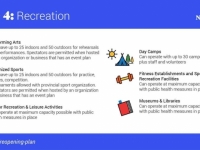Travel
Phase 4 of Nova Scotia Reopening Plan
Takes Effect On Wednesday July 14th

Phase 4 Slide (Source: Communications Nova Scotia )
USPA NEWS -
"We're pleased with vaccination rates and our epidemiology continues to improve, putting us in a good position to move to Phase 4 of our reopening plan and will do so on Wednesday July 14th. This doesn't mean we can let our guard down, but it does mean we can enjoy larger gatherings and support businesses by exploring all that Nova Scotia has to offer this summer." Premier Iain Rankin said in his opening remarks at Monday's COVID-19 media briefing.
Premier Iain Rankin and Dr. Robert Strang, the Chief Medical Officer for Nova Scotia, both credit Nova Scotians for stepping up to the plate by following public health guidelines and by getting vaccinated. This hard work puts the province in the position to move forward into Phase 4 of the reopening plan. When questioned about different approaches that other provinces are taking to remove most or all Public Health restrictions, Premier Rankin advised that He and Dr. Strang will be monitoring very closely to see the impacts of the different approach.
The highlights of Phase 4 of the Nova Scotia Reopening Plan are as follows:
Gatherings/ People can have informal gatherings with their household members and close social contacts to a maximum of 25 indoors or 50 outdoors without physical distancing or masks, unless they are in a public place where masks are required. Faith gatherings, weddings, funerals and associated receptions and visitation hosted by a recognized business or organization can have 50 per cent capacity to a maximum of 150 people indoors or 250 people outdoors.
Continuing Care/ All long-term care residents can leave the facility to visit indoor and outdoor public places like parks, stores and restaurants, fully vaccinated residents can have visitors in their rooms and visit their family's home, including overnight stays, and residents who are not fully vaccinated can have visitors in designated indoor visitation areas.
Business/ Restaurants, licensed establishments and casinos continue to operate with existing mask and distancing rules. There can be up to 25 people per table and customers can go to the bar to order. Establishments can return to their normal service hours and they can have performers following the limit for arts and culture performances. Events hosted by a recognized business or organization can have 50 per cent capacity to a maximum of 150 people indoors or 250 people outdoors and organizers need a plan following guidelines for events. People can follow the informal gathering limit for dancing together at events and at bars or restaurants, with distance between groups. The indoor limit applies to dancing indoors and on patios at bars or restaurants. All retail stores can operate at maximum capacity with public health measures in place, including distancing and masks. Meetings and training hosted by a recognized business or organization can have 50 per cent capacity to a maximum of 150 people indoors or 250 people outdoors.
Arts and Culture/ Professional and amateur arts and culture rehearsals and performances can involve up to 25 people indoors and 50 outdoors without physical distancing. Audiences follow the gathering limits for events hosted by a recognized business or organization. Museums, libraries and the Art Gallery of Nova Scotia can open at maximum capacity with public health measures in place, including distancing and masks.
Recreation and Sport/ Fitness and recreation facilities such as gyms, yoga studios, pools and arenas can operate at maximum capacity with public health measures in place which includes distancing and masks. A wide variety of recreation and leisure businesses and organizations, such as dance classes, music lessons, escape rooms and indoor play spaces, can operate at maximum capacity with public health measures in place, including distancing and masks. Organized sports practices, games, league play, competition and recreation programs can involve up to 25 people indoors and 50 people outdoors without physical distancing: tournaments are allowed when they are run by or affiliated with a provincial sport organization, following their Return to Sport plan. Audiences follow the gathering limits for events hosted by a recognized business or organization. Day camps can operate with 30 campers per group plus staff and volunteers, following the day camp guidelines. Masks are no longer required for children age 12 and under in child-care settings, including day camps and overnight camps. Masks are no longer required at outdoor public places where it may be difficult to maintain physical distance, such as markets, playgrounds and parks.
In Dr Strang's remarks he said, "We continue to encourage everyone to get two doses of vaccine as soon as possible. That is the key to continuing our reopening and getting to a stage where restrictions can end. Until then, we need to continue protecting each other by following these public health measures and getting tested regularly."
Dr Strang strongly discouraged people from waiting for Pfizer for a couple of reasons: One, youth aged 12-17 can only take Pfizer and there is lots of Moderna available, so adults should get that as soon as possible. Dr Strang said, "Anyone who is simply waiting for Pfizer, please do not wait. There is no difference between the two. You get the same end result and you get strong immunity against COVID-19. Waiting keeps you and others at risk.The Delta variant is in other provinces. One dose is not enough to protect you against this variant."
Dr. Strang advised that there are thousands of appointments currently available throughout the province and pleaded with Nova Scotians to book their vaccination appointments as soon as possible.
He closed by saying, the sooner everyone gets vaccinated the sooner that further restrictions can be lifted.
Liability for this article lies with the author, who also holds the copyright. Editorial content from USPA may be quoted on other websites as long as the quote comprises no more than 5% of the entire text, is marked as such and the source is named (via hyperlink).








